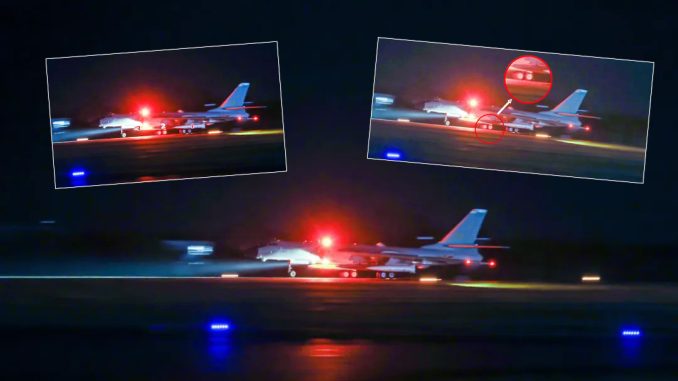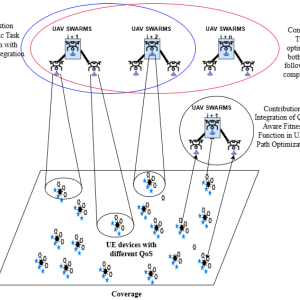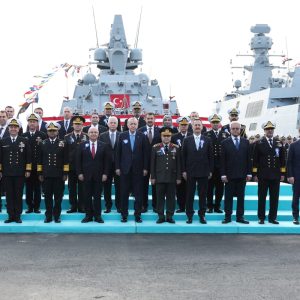In a significant development that underscores China’s growing military capabilities, the H-6K bomber has been observed carrying four “carrier killer” ballistic missiles. H-6K bomber, a New Era in Aerial Warfare? This unprecedented sighting marks a pivotal moment in the evolution of modern warfare, showcasing the People’s Liberation Army Air Force’s (PLAAF) expanding reach and tactical versatility. As defense analysts and global military strategists scrutinize this revelation, it is imperative to delve into the details and implications of this advanced aerial deployment.

The H-6K Bomber: A New Era in Aerial Warfare?
The H-6K bomber, a modernized version of the venerable H-6 aircraft, represents a cornerstone of China’s strategic bomber fleet. Equipped with state-of-the-art avionics, powerful engines, and advanced weaponry, the H-6K is designed for long-range strike missions and precision attacks. This platform’s capability to carry ballistic missiles significantly enhances its operational range and lethality, making it a formidable asset in China’s arsenal.
Key Features of the H-6K Bomber:
- Advanced Avionics: The H-6K boasts sophisticated avionics systems, including improved radar, electronic warfare suites, and enhanced navigation capabilities. These upgrades ensure precise targeting and effective countermeasures against enemy defenses.
- Powerful Engines: The bomber is powered by modern turbofan engines, providing greater thrust and efficiency. This allows the H-6K to undertake extended missions with substantial payloads.
- Weapon Systems: The H-6K is armed with a variety of conventional and nuclear-capable munitions. Its ability to carry ballistic missiles, as demonstrated in recent sightings, significantly extends its strategic impact.
Carrier Killer Ballistic Missiles: A Game-Changer
The term “carrier killer” refers to ballistic missiles specifically designed to target and neutralize aircraft carriers, which are pivotal assets in naval warfare. The DF-21D and DF-26 ballistic missiles, often associated with this moniker, possess capabilities that challenge the conventional dominance of carrier strike groups.
Characteristics of Carrier Killer Ballistic Missiles:
- Range and Speed: These missiles can cover distances exceeding 1,500 kilometers at high velocities, making them capable of striking targets well beyond the immediate battlefront.
- Precision Targeting: Equipped with advanced guidance systems, carrier killer missiles can accurately home in on moving targets, such as aircraft carriers, thereby disrupting naval operations and force projection.
- Payload and Destructive Power: Designed to carry conventional or nuclear warheads, these missiles can inflict significant damage upon impact, rendering critical naval assets inoperable.
Strategic Implications of the H-6K’s New Capability
The deployment of carrier killer ballistic missiles on the H-6K bomber has profound strategic implications for regional and global security dynamics. This capability enhances China’s anti-access/area denial (A2/AD) strategy, aimed at deterring adversaries from intervening in its sphere of influence.
Key Strategic Implications:
- Extended Reach: The ability to launch carrier killer missiles from airborne platforms like the H-6K extends China’s strike range, enabling it to target distant naval assets and critical infrastructure.
- Deterrence: The enhanced strike capabilities serve as a potent deterrent against potential military interventions by adversaries, particularly in contested regions such as the South China Sea and the Taiwan Strait.
- Power Projection: By integrating ballistic missiles into its bomber fleet, China can project power more effectively across the Indo-Pacific region, challenging the strategic presence of rival powers.
- Operational Flexibility: The flexibility to deploy various munitions, including ballistic missiles, allows the H-6K to adapt to diverse combat scenarios, enhancing its overall operational effectiveness.
Technological Advancements in Ballistic Missile Integration
Integrating ballistic missiles onto an airborne platform like the H-6K involves significant technological advancements. This process requires meticulous engineering to ensure compatibility, stability, and effective launch mechanisms.
Critical Technological Aspects:
- Launch Systems: The development of robust launch systems that can withstand the stress of airborne operations is crucial. These systems must ensure reliable missile deployment under various flight conditions.
- Guidance and Control: Advanced guidance and control technologies are essential for ensuring missile accuracy. Integration with the bomber’s avionics allows for real-time targeting adjustments and precise trajectory management.
- Payload Adaptation: Modifying the bomber to accommodate the physical and operational requirements of ballistic missiles involves structural reinforcements and adjustments to internal systems.
- Electronic Warfare Integration: Incorporating electronic warfare capabilities to counter potential interception and jamming attempts is vital for the successful deployment of carrier killer missiles.
Historical Context: Evolution of China’s Aerial Strike Capabilities
The sighting of the H-6K carrying four carrier killer ballistic missiles represents the latest chapter in China’s long-standing efforts to enhance its aerial strike capabilities. Over the decades, China has steadily advanced its bomber technology, transitioning from early Soviet designs to indigenous platforms equipped with cutting-edge technologies.
Key Milestones in China’s Aerial Strike Development:
- Early Developments: Initial advancements in China’s bomber fleet were heavily influenced by Soviet designs, with the H-6 being a derivative of the Tupolev Tu-16.
- Modernization Efforts: In recent years, China has undertaken extensive modernization efforts, integrating advanced avionics, weapon systems, and propulsion technologies into its bomber fleet.
- Strategic Focus: The strategic focus has shifted towards developing long-range strike capabilities, enabling China to project power across the Asia-Pacific region and beyond.
- Integration of Ballistic Missiles: The integration of ballistic missiles into the H-6K platform represents a significant leap forward, aligning with China’s broader military modernization goals.
Geopolitical Ramifications and Global Response
The deployment of carrier killer ballistic missiles on the H-6K bomber is likely to elicit strong reactions from global powers, particularly those with significant naval assets in the Indo-Pacific region. The geopolitical ramifications of this development are profound, influencing military strategies, alliances, and regional stability.
Geopolitical Considerations:
- Regional Power Dynamics: The enhanced capabilities of the H-6K are likely to shift regional power dynamics, prompting neighboring countries to reassess their military strategies and defense postures.
- US Naval Strategy: The United States, with its extensive carrier fleet, may need to adapt its naval strategy to counter the emerging threat posed by China’s carrier killer capabilities. This could involve increased investment in missile defense systems and advanced countermeasures.
- Alliances and Partnerships: The development may strengthen existing alliances and prompt the formation of new partnerships among countries seeking to counterbalance China’s growing military capabilities.
- Arms Race Concerns: The sighting of the H-6K with ballistic missiles could escalate an arms race in the region, with countries seeking to develop or acquire similar capabilities to maintain a strategic equilibrium.
Operational Scenarios and Tactical Applications
Understanding the operational scenarios and tactical applications of the H-6K bomber armed with carrier killer ballistic missiles provides insight into potential combat strategies and mission profiles.
Potential Operational Scenarios:
- Anti-Carrier Operations: In a conflict scenario, the H-6K could be deployed to target enemy aircraft carriers, disrupting naval operations and diminishing the adversary’s power projection capabilities.
- Strategic Strikes: The bomber could undertake strategic strikes against critical infrastructure, such as naval bases, command centers, and logistics hubs, crippling the enemy’s operational capacity.
- A2/AD Missions: The H-6K could play a pivotal role in A2/AD missions, enforcing a perimeter that prevents adversaries from gaining access to strategically important regions.
- Deterrence Patrols: Regular patrols armed with carrier killer missiles could serve as a deterrent, signaling China’s readiness to respond to potential threats decisively.
Conclusion: A Transformative Advancement in Military Capabilities
The sighting of China’s H-6K bomber carrying four carrier killer ballistic missiles marks a transformative advancement in military capabilities. This development underscores China’s commitment to enhancing its strategic reach and operational flexibility, positioning it as a formidable force in modern warfare. As global military powers assess the implications of this revelation, the strategic landscape is poised for significant shifts, heralding a new era of aerial and naval warfare.










